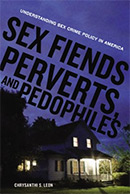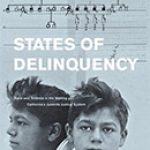Sex Fiends, Perverts, and Pedophiles: Understanding Sex Crime Policy in America

Author: Leon, Chrysanthi S.
New York: New York University Press, 2011. 253 p.
Reviewer: David Patrick Connor | July 2012
Over the past several years, individuals convicted of sex offenses in the United States have been subjected to increasingly harsh sanctions. Criminal justice efforts have increased the supervision of these criminals and decreased their opportunities to further perpetuate crimes. Providing a chronological examination into how the social construction of the ideal type of sex offender influences such laws and policies, Sex Fiends, Perverts, and Pedophiles competently describes criminal registration, community notification, residency restrictions, civil commitment, and the progressively longer incarcerations that epitomize America’s current punitive approach toward sex offenders.
Broken into eight chapters, with additional introduction and conclusion sections, the book successfully places contemporary criminal justice policies aimed at sex offenders in a historical context. As both a legal expert and criminologist, Leon offers a solid, contextualized explanation of sex offender punishment throughout three distinct time periods. Using a mixed methods approach, including archival research, descriptive statistics, and participant observation, Leon examines the relationship between public images of sex offenders and strategies devised to deal with such criminals. This allows readers to see the driving forces behind modern social and political responses to sex offenders and sex offenses in American society.
Identifying popular sex offender images and common fallacies that form the foundation of many sex offender laws, both past and present, the first chapter may be the most interesting. Here, Leon constructs a typology of what she views as the three most salient images of sex offenders from the 1930s to the present day (i.e., monster, patient, and nuisance). Most notably, the “monster” is considered to be an untreatable deviant who is unable to exercise restraint and certain to generate harm and damage through sexual violence. It is this image of sex offenders that is both described as having come to dominate public fears and being partially responsible for severe responses that exemplify modern sex offender policies.
Next, Leon delves into what is described as the sexual psychopath era, which she believes took place roughly between 1930 and 1955. As presented, both the mass media and criminal laws during this time period consistently portrayed sex offenders as crazed individuals with insatiable sexual appetites. In the third and fourth chapter, the so-called rehabilitative debate that was prominent between 1950 and 1980 is featured. In this era, new treatment approaches from psychiatry and psychology were receiving public interest, and they are described as having offered a limited testing ground for rehabilitating sex offenders. However, sex offenders were still regarded as sick individuals who were unable to control their pathological impulses, and the apparent failure of such treatment strategies is identified as having prepared the way for the highly punitive approach that sex offenders encounter today.
Modern criminal justice policies aimed at sex offenders, as well as the transformed public image of sex offenders as sexual predators, are examined later in the text. Leon describes the containment era (1980 to present), during which she argues responses to sex offenders are the harshest. As a result of federalization of criminal laws, responses to sex offenders are now more uniform across American jurisdictions. Treatment and retribution are prevalent sex offender management strategies, but so too has incapacitation through long-term imprisonment become widespread. This, at least in the eyes of Leon, makes way for a society that unnecessarily uses incarceration as a preferred method of dealing with sex offenders.
Ultimately, this book demonstrates committed scholarship and imparts a high-quality analysis of both public attitudes and beliefs toward sex offenders and criminal justice policies targeting such offenders from the 1930s to the present day. The detailed examination of incarceration patterns among convicted sex offenders is also notable. Leon successfully illustrates that sex offender policies throughout time function to increase social bonds and declare moral boundaries, but as later chapters more fully reveal, differentiation among sex offenders based on empirical knowledge, rather than misguided notions, is necessary for the most effective criminal justice policies to emerge.
David Patrick Connor, Doctoral Student, University of Louisville


